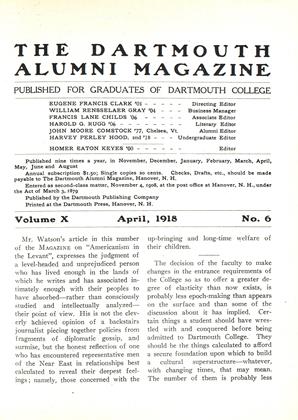by FRANCIS H. HERRICK '81. 2 vols.; D. Appleton & Co.
The thrilling story of Audubon's travels and of his experiences in publishing his famous book has often been told, but the details of his early life have remained a mystery, and, in fact, were a mystery even to Audubon himself. Prof. Herrick, in preparing this biography, has had access to many newly discovered documents and is able to give for the first time a complete account of the birth and parentage of this famous naturalist. Audubon's father was an officer in the French navy and his mother was a Creole woman of Santo Domingo. He was born in Santo Domingo and was educated in France. Herrick devotes several chapters to describing social conditions in France and the colonies at that time, and he proves and illustrates his points by numerous quotations from old records, bills, and deeds. This part of the biography, although of considerable general interest, has evidently been written especially for the professional naturalists.
The general public will take more interest in the history of Audubon's book, "The Birds of America." Herrick shows that in size, expense of printing, and difficulties of selling, this book ranks among the first ever undertaken by any author, and in scientific value it has remained the one great classic of ornithology. Audubon explored nearly all of North America east of the Rockies in search of specimens of rare birds. His paintings were usually begun in the field from freshly killed birds supported by wires in a natural environment. The figures, even of cranes and wild turkeys, were drawn life size and published life size. The book was published in several volumes in London under the author's supervision. The pictures, about 500 in number, were carefully engraved and colored by hand. The cost of publication was about $100,000 and each complete set was sold for about $1,000. Audubon was his own selling agent. Among his buyers was Daniel Webster, who offered to assist in the work by supplying some rare sea fowl of his own killing. King George of England was. also a subscriber, but like many others he never paid his bill. Louis Phillipe and Baron Rothschild and many other famous names were on the list. Many public institutions bought sets and today Trinity College possesses the best set in existence. Many sets were broken up by book sellers and the individual plates sold for big prices.
Audubon's drawings seem to have been made with great care and his observations were usually very accurate, but, nevertheless, he has been accused of nature faking. Herrick defends him on several counts. The famous "yellow water lily" has, according to Herrick, been found growing in the swamps of the south as yellow as it was painted. Rattlesnakes "have been found with sharply recurved fangs just as Audubon represented them, and a photograph is entered in Herrick's book as proof. There is circumstantial evidence to show that a rattlesnake might climb a tree, and possibly rob a bird's nest as shown in one of Audubon's pictures, but even an ardent admirer like Herrick is not able to swallow the snake story in which a rattler chases a squirrel up a tree and out over the high limbs. However, in spite of a few rather doubtful instances, Herrick seems quite justified in his conclusion that Audubon's work on the whole has proved to be a very valuable piece of scientific research.
L. G.
Willard Connelly '11 is the author of New Developments in Training Wartime Sailors," which appeared in the Scientific American for December 29 1917.
The Dust of Death," by Ben Armes Williams '10, appears in the March 2 issue of the All-Story Weekly.
"The Reliability of Mental Tests in the Division of an Academic Group," by Beardslev Ruml '15. has just been issued by the Psychological Review Co. of Princeton. N. J., as number 4 of volume 24 of Psychological Monographs.
"Flood Tide" by Daniel Chase (Ernest Howard Chase '14) published by the MacMillan Co., will be reviewed in a later issue.
Judge Charles M. Hough '79 is the author of "Law in War Time—1917". to be found in the March issue of the Harvard Law Review.
 View Full Issue
View Full Issue
More From This Issue
-
 Article
ArticleCOLLEGE NEWS
April 1918 -
 Article
ArticleANNUAL MEETING OF THE DARTMOUTH SECRETARIES ASSOCIATION
April 1918 -
 Article
ArticleAMERICANISM IN THE LEVANT
April 1918 By Ernest Bradlee Watson '02 -
 Article
ArticleMr. Watson's article in this number of the MAGAZINE on "Americanism
April 1918 -
 Article
ArticleTWO LETTERS FROM THE FRONT
April 1918 -
 Article
ArticleDEATH OF LIEUTENANT EADIE '18
April 1918 By FRANK N. HUME
L.G.
Books
-
 Books
BooksQuestions on the Principles of Economics
January 1916 -
 Books
BooksFACULTY PUBLICATIONS
April 1920 -
 Books
BooksShelf Life
May/June 2004 -
 Books
BooksTHE HAND IN THE PICTURE,
November 1947 By Eric P., THEODORE KARWOSKI -
 Books
BooksELMER SQUEE,
May 1942 By Herbert F. West '22 -
 Books
BooksBRIGHT SALMON AND BROWN TROUT.
MARCH 1965 By PAUL SAMPLE '20




